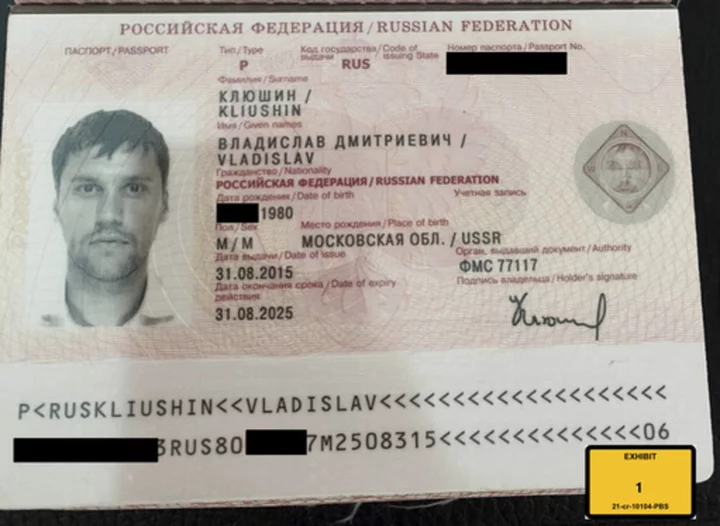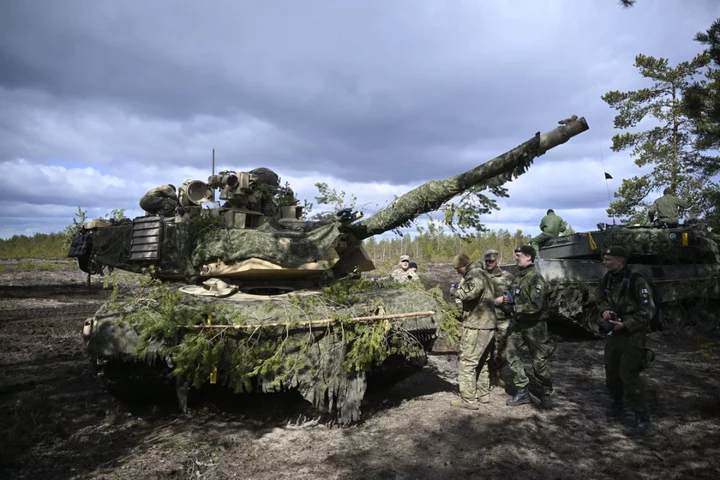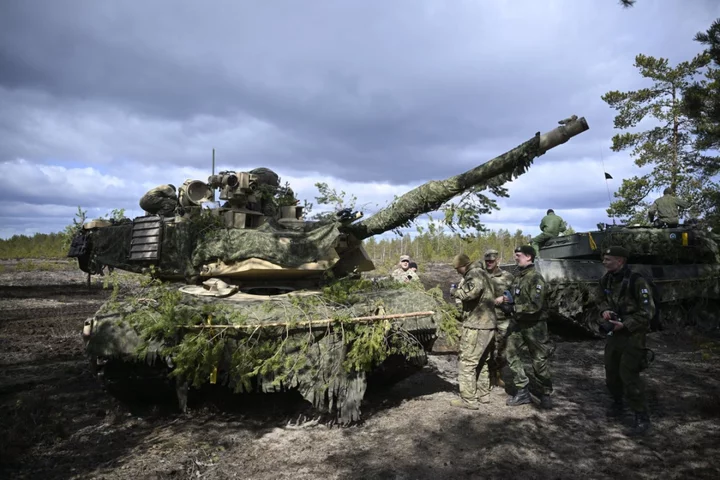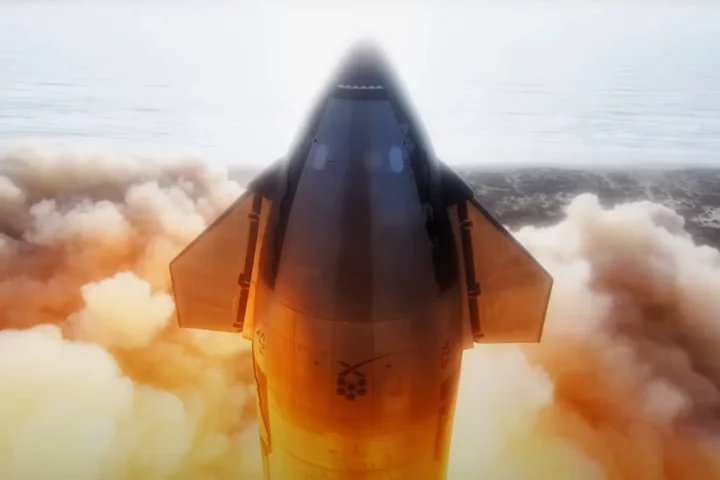
What is the G20 and why does the Delhi summit matter?
India wants the G20 Delhi summit to focus on the environment, but there may be rows over Ukraine.
2023-09-07 23:24

Biden announces Michael Whitaker as FAA pick
President Joe Biden intends to nominate Michael Whitaker as administrator of the Federal Aviation Administration, the White House announced Thursday.
2023-09-07 23:19

Man arrested for brutal sexual assault and beating of Wisconsin college student pretended he found victim
A suspect accused of brutally raping and beating a University of Wisconsin student reportedly pretended to be an innocent bystander after the vicious attack. Brandon Thompson, 26, is facing charges of sexual assault, reckless injury, and strangulation in connection with the attack that left a young woman in her 20s critically injured, the Madison Police Department said. Madison Police Chief Shon Barnes said that around 3.20am on Sunday, a witness heard a commotion and approached the scene. Mr Thompson was standing next to the victim and reportedly told the witness that he had “just found” her and didn’t know what had happened. While the witness called emergency services, Mr Thompson fled the scene in his vehicle. The victim, a student at the University of Wisconsin-Madison, suffered a broken jaw and other life-threatening injuries. She is in critical condition but is expected to survive. “I think one of the most frightening things [is that it was a random attack],” Chief Barnes said at a press conference on Wednesday. “...This case will not be complete until this cowardly attacker receives the justice he deserves.” Investigators were able to link Mr Thompson to the scene thanks to surveillance video submitted by residents of the area that captured Mr Thompson’s license plate and that he was walking right behind the victim before the attack unfolded. Chief Barnes said that approximately two hours before the attack, Mr Thompson was pulled over by Fitchburg police officers over a registration violation. The neighbouring police department provided bodycam footage from the traffic stop that showed Mr Thompson’s clothing matched what he was wearing during the Madison attack. “As a result of this video, detectives were able to read a license plate that directly led to the identification of Brandon Thompson as the perpetrator of this assault,” Assistant Chief Paige Valenta of the Madison Police Department said. Ms Valenta said that DNA evidence had been collected from the scene and sent to a state crime lab. “Her life is forever changed,” Ms Valenta added. “Her family’s life is forever changed. We will continue to work hard to ensure that Mr Thompson is held fully accountable in a court of law for the heinous act he perpetrated.” The suspect’s attorneys said in a statement to TMJ4 that he is a graduate of the University of Wisconsin at Milwaukee and has a degree in criminal justice and psychology. He reportedly works for a biotech company in Madison. Madison police said Mr Thompson appeared to have no connection with the victim. He was arrested on Wednesday morning and is now awaiting official charges. Read More Famed tech journalist deletes X account with epic rant at Elon Musk and his ‘cesspool’ site The president of a Japanese boy band company resigns and apologizes for late uncle's sex abuse MLB places Dodgers pitcher Julio Urías on administrative leave after arrest
2023-09-07 23:19

Prosecutor in Georgia election case against Trump and others seeks protections for jurors
The Georgia prosecutor who has brought charges accusing former President Donald Trump and others of illegally trying to overturn the results of the 2020 election in the state is asking the judge in the case to take steps to protect jurors in the case
2023-09-07 23:19

Wealthy Russian with Kremlin ties gets 9 years in prison for hacking and insider trading scheme
A federal judge in Boston has sentenced a wealthy Russian businessman with ties to the Kremlin to nine years in prison for his role in a nearly $100 million insider trading scheme that relied on stolen company earnings information hacked through U.S. computer networks
2023-09-07 23:16

What are depleted uranium shells? The controversial armour-piercing muntions being used in Ukraine
The depleted uranium anti-tank rounds soon to be in Ukraine’s military stockpiles have kicked up a debate over its use in the continuing Russian invasion. Announced by the Pentagon in the latest military tranche on Wednesday, the controversial rounds have spread alarm among Vladimir Putin’s ministers who have warned against the escalation yet again. Britain has already promised armour-piercing rounds containing depleted uranium to Ukraine in March. Prime minister Rishi Sunak had backed drawing out the rounds from the UK military’s stockpiles ultimately “to degrade and deter – primarily – Russian aggression”. But what are these depleted uranium munitions? The 120mm anti-tank shells made of depleted uranium are self-sharpening and flammable penetrator in munitions. They are made of naturally occurring Uranium which has been stripped of mostly – not all – of its radioactive matter. So while it is not a nuclear weapon in itself, it acts as a fuel and also as a great explosive that can be used in tank armour, pressed between sheets of steel armour plate. They can be paired with top-tier tanks Western nations have already provided to Ukraine, and are particularly expected to boost the performance of 31 M1A1 Abram tanks set to be sent to the war-hit nation this fall. These rounds first emerged in the 1970s when the US army started making the armour-piercing rounds and has since used it along with tank armour to multiply the firing effect. Incredibly dense, more than lead, depleted uranium is considered a top-tier choice for projectiles. When fired, it becomes “essentially an exotic metal dart fired at an extraordinarily high speed”, RAND senior defence analyst Scott Boston said. “It’s so dense and it’s got so much momentum that it just keeps going through the armour – and it heats it up so much that it catches on fire,” Edward Geist, a nuclear expert at research organisation RAND said. The depleted uranium has also been added to the US ammunition fired by the Air Force’s A-10 close air support attack plane, known as the tank killer. Depleted uranium munitions, as well as depleted uranium-enhanced armour, have been previously used by US tanks in the 1991 Gulf War against Iraq’s T-72 tanks and again in the invasion of Iraq in 2003, as well as in Serbia and in Kosovo. Is the risk alarming? The UN nuclear watchdog has warned of the emissions of low levels of radiation from depleted uranium when handling and also warned of possible dangers of explosion. This is a bug, not a feature of the munition, says Mr Geist. Categorically, depleted uranium is not marked as a nuclear weapon. It is mainly a toxic chemical, as opposed to a radiation hazard. Particles in aerosols can be inhaled or ingested, and while most would be excreted again, some can enter the bloodstream and cause kidney damage. “High concentrations in the kidney can cause damage and, in extreme cases, renal failure,” the International Atomic Energy Agency has said. The US troops have questioned whether some of the ailments they now face were caused by inhaling or being exposed to fragments after a munition was fired or their tanks were struck, damaging uranium-enhanced armour. Experts have said that if the US military could find another material with the same density but without the radioactivity, it would likely switch. The IAEA has warned that handling of depleted uranium “should be kept to a minimum and protective apparel (gloves) should be worn” and “a public information campaign may, therefore, be required to ensure that people avoid handling the projectiles”. Initial signs of radioactivity from the Ukraine war have started trickling in. Russian foreign ministry spokesperson Maria Zakharova had recently claimed that the use of these munitions has already led to radioactive contamination. How has Russia reacted? In March, Russia was fuming after the Rishi Sunak administration announced it will give depleted uranium rounds to Ukraine, prompting them to issue nuclear threats. This time, after the US joined Britain in sending the depleted uranium shells, Moscow snapped and called the latest military aid of depleted uranium a “criminal act” beyond just escalation. “It is a reflection of Washington’s outrageous disregard for the environmental consequences of using this kind of ammunition in a combat zone. This is, in fact, a criminal act, I cannot give any other assessment,” Russian deputy foreign minister Sergei Ryabkov said. He also reiterated previous warnings by Russia about the risk of a nuclear war, because of what he called Western “pressure” on Moscow. “Now this pressure is dangerously balancing on the brink of direct armed conflict between nuclear powers,” he said. In March, Vladimir Putin had warned that Moscow would "respond accordingly, given that the collective West is starting to use weapons with a ‘nuclear component.’” Several days later, Putin said Russia’s response will see Moscow stationing tactical nuclear weapons in neighbouring Belarus, action to which effect was announced in July as Putin and the Belarusian president said they had already shipped some of the weapons. Read More The Body in the Woods | An Independent TV Original Documentary The harrowing discovery at centre of The Independent’s new documentary US sends Ukraine controversial depleted uranium weapons that can pierce tank armour UN nuclear watchdog report seen by AP says Iran slows its enrichment of near-weapons-grade uranium Kyiv drones explode near Moscow and military HQ as Russia on defensive – live
2023-09-07 22:57

Foreign Relations chair seeks answers from US oil firms on Russia business after Ukraine invasion
The head of the U.S. Senate Foreign Relations Committee has asked America's top three oilfield services companies to explain why they continued doing business in Russia after its invasion of Ukraine
2023-09-07 22:54

What are depleted uranium munitions being used in Ukraine and why are they controversial?
The depleted uranium anti-tank rounds soon to be in Ukraine’s military stockpiles have kicked up a debate over its use in the continuing Russian invasion. Announced by the Pentagon in the latest military tranche on Wednesday, the controversial rounds have spread alarm among Vladimir Putin’s ministers who have warned against the escalation yet again. Britain has already promised armour-piercing rounds containing depleted uranium to Ukraine in March. Prime minister Rishi Sunak had backed drawing out the rounds from the UK military’s stockpiles ultimately “to degrade and deter – primarily – Russian aggression”. But what are these depleted uranium munitions? The 120mm anti-tank shells made of depleted uranium are self-sharpening and flammable penetrator in munitions. They are made of naturally occurring Uranium which has been stripped of mostly – not all – of its radioactive matter. So while it is not a nuclear weapon in itself, it acts as a fuel and also as a great explosive that can be used in tank armour, pressed between sheets of steel armour plate. They can be paired with top-tier tanks Western nations have already provided to Ukraine, and are particularly expected to boost the performance of 31 M1A1 Abram tanks set to be sent to the war-hit nation this fall. These rounds first emerged in the 1970s when the US army started making the armour-piercing rounds and has since used it along with tank armour to multiply the firing effect. Incredibly dense, more than lead, depleted uranium is considered a top-tier choice for projectiles. When fired, it becomes “essentially an exotic metal dart fired at an extraordinarily high speed”, RAND senior defence analyst Scott Boston said. “It’s so dense and it’s got so much momentum that it just keeps going through the armour – and it heats it up so much that it catches on fire,” Edward Geist, a nuclear expert at research organisation RAND said. The depleted uranium has also been added to the US ammunition fired by the Air Force’s A-10 close air support attack plane, known as the tank killer. Depleted uranium munitions, as well as depleted uranium-enhanced armour, have been previously used by US tanks in the 1991 Gulf War against Iraq’s T-72 tanks and again in the invasion of Iraq in 2003, as well as in Serbia and in Kosovo. Is the risk alarming? The UN nuclear watchdog has warned of the emissions of low levels of radiation from depleted uranium when handling and also warned of possible dangers of explosion. This is a bug, not a feature of the munition, says Mr Geist. Categorically, depleted uranium is not marked as a nuclear weapon. It is mainly a toxic chemical, as opposed to a radiation hazard. Particles in aerosols can be inhaled or ingested, and while most would be excreted again, some can enter the bloodstream and cause kidney damage. “High concentrations in the kidney can cause damage and, in extreme cases, renal failure,” the International Atomic Energy Agency has said. The US troops have questioned whether some of the ailments they now face were caused by inhaling or being exposed to fragments after a munition was fired or their tanks were struck, damaging uranium-enhanced armour. Experts have said that if the US military could find another material with the same density but without the radioactivity, it would likely switch. The IAEA has warned that handling of depleted uranium “should be kept to a minimum and protective apparel (gloves) should be worn” and “a public information campaign may, therefore, be required to ensure that people avoid handling the projectiles”. Initial signs of radioactivity from the Ukraine war have started trickling in. Russian foreign ministry spokesperson Maria Zakharova had recently claimed that the use of these munitions has already led to radioactive contamination. How has Russia reacted? In March, Russia was fuming after the Rishi Sunak administration announced it will give depleted uranium rounds to Ukraine, prompting them to issue nuclear threats. This time, after the US joined Britain in sending the depleted uranium shells, Moscow snapped and called the latest military aid of depleted uranium a “criminal act” beyond just escalation. “It is a reflection of Washington’s outrageous disregard for the environmental consequences of using this kind of ammunition in a combat zone. This is, in fact, a criminal act, I cannot give any other assessment,” Russian deputy foreign minister Sergei Ryabkov said. He also reiterated previous warnings by Russia about the risk of a nuclear war, because of what he called Western “pressure” on Moscow. “Now this pressure is dangerously balancing on the brink of direct armed conflict between nuclear powers,” he said. In March, Vladimir Putin had warned that Moscow would "respond accordingly, given that the collective West is starting to use weapons with a ‘nuclear component.’” Several days later, Putin said Russia’s response will see Moscow stationing tactical nuclear weapons in neighbouring Belarus, action to which effect was announced in July as Putin and the Belarusian president said they had already shipped some of the weapons. Read More The Body in the Woods | An Independent TV Original Documentary The harrowing discovery at centre of The Independent’s new documentary Ukraine war: What are depleted uranium shells and why are they controversial? US sends Ukraine controversial depleted uranium weapons that can pierce tank armour UN nuclear watchdog report seen by AP says Iran slows its enrichment of near-weapons-grade uranium
2023-09-07 22:52

Convicted of embezzlement, former Baltimore Mayor Sheila Dixon is running again
Former Baltimore Mayor Sheila Dixon is again running for office after her previous mayoral tenure ended in a criminal conviction
2023-09-07 22:22

Suspected Chinese operatives using AI generated images to spread disinformation among US voters, Microsoft says
Suspected Chinese operatives have used images made by artificial intelligence to mimic American voters online in an attempt to spread disinformation and provoke discussion on divisive political issues as the 2024 US election approaches, Microsoft analysts warned Thursday.
2023-09-07 22:21

SpaceX launch of Starship rocket on hold amid ‘mishap investigation’
SpaceX will not be cleared to launch its 400-foot-tall (121 metre) Starship rocket until a “mishap investigation” is completed, regulators have said. A statement from the Federal Aviation Administration (FAA) warned of a launch delay for the biggest rocket ever built, just hours after SpaceX boss Elon Musk said the craft was “ready to launch” on Wednesday. SpaceX made its first and only attempt at an orbital Starship launch in April, with the rocket exploding over the Gulf of Mexico just three minutes into the 90 minute flight. The crewless rocket broke up into pieces over an empty stretch of water, however the debris blast created by Starship’s huge engines at its launchpad drew heavy scrutiny from regulators. Concrete dust drifted more than 10 kilometres from the launch site, according to the Fish and Wildlife Service, while concrete chunks and metal shards were discovered within a 700-acre zone surrounding the pad. SpaceX claimed the mission was a success, as Starship and its Super Heavy booster were able to lift off on its maiden test flight, however the FAA launched an investigation soon afterwards. Following Mr Musk’s latest comments that the latest version of the rocket is ready to launch pending regulatory approval, the FAA warned SpaceX that it would need to wait for the investigation to conclude. “The SpaceX Starship mishap investigation remains open,” the FAA said in a statement. “The FAA will not authorise another Starship launch until SpaceX implements the corrective actions identified during the mishap investigation and demonstrates compliance with all the regulatory requirements of the licence modification process.” SpaceX has made numerous alterations and improvements to Starship and its launch pad, including remedial measures aimed at preventing launch debris and a new method for separating the upper stage from its booster rocket. Nasa has already awarded SpaceX a multi-billion dollar contract to develop Starship for its Artemis program, which aims to return humans to the surface of the Moon for the first time in more than 50 years. Mr Musk also plans to use the rockets for more ambitious longer term goals, including establishing a permanent human colony on Mars before 2050. “As the most powerful launch system ever developed, Starship will be able to carry up to 100 people on long-duration, interplanetary flights,” SpaceX notes on its website. “Starship will also help enable transport of many satellites, large space telescopes, and significant amounts of cargo to Earth orbit, the Moon, Mars and beyond.” Read More ‘It’s becoming like an airport’: How SpaceX normalised rocket launches SpaceX abandons YouTube for live streams of launches in favour of X/Twitter Starship ‘ready to launch’, Elon Musk says SpaceX crew streak across sky before splashing down off Florida coast SpaceX smashes rocket launch record as Musk eyes historic Starship mission
2023-09-07 21:57

Outrage over Abbas's antisemitic speech on Jews and Holocaust
German and Israeli officials condemn the Palestinian leader's remarks about the mass murder of Jews.
2023-09-07 21:29
